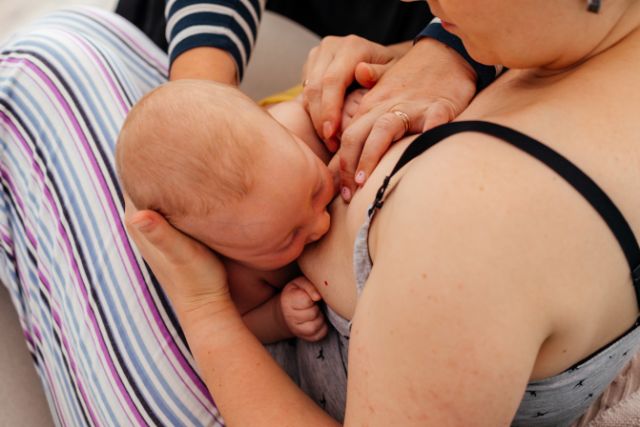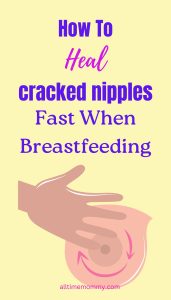Breastfeeding doesn’t have to be a painful moment anymore. Learn the best natural ways you can heal cracked nipples fast when breastfeeding.
For a first-time mom, you probably will encounter cracked or sore nipples within the first two weeks of breastfeeding.
The pain may be so much that you may think of an alternative way of feeding your baby. But don’t worry, mama,
I have some solutions for you.
But before diving into solutions, let’s first examine the possible causes of pain and cracked nipples
How Common are Nipple Fissures?
Nipple fissures or painful cracks on the nipple while breastfeeding is very common, especially for first-time moms.
It’s estimated that about 80 % to 90% of breastfeeding mothers may experience painful and cracked nipples during the second or third week after their delivery.
But,
Are Cracked and Painful Nipples Normal?
No. Even though many new mothers experience creaked nipples, it’s not normal. Nipple fissures may result from too much straining on your nipple tissue.
You should thus, ensure that you try to prevent further injury by looking into the causes of the pains. Similarly, you need to help these breast tissues to heal while preventing further complications.
What Does a Cracked Nipple Look Like?
Dry and chafed. Sometimes it may be itchy, crusty, and sored with pale or dark scars around the areola. You will feel nipple pain during breastfeeding, especially when the baby latches.
What Causes Cracked Nipples in Breastfeeding Mothers?
Cracked nipples can occur due to many reasons, among them being:
- Improper latching: How you position and hold your baby on the breast can contribute to cracked nipples. When properly latched, the nipple is in contact with the baby’s soft palate-the back of the baby’s mouth, which is soft and may reduce nipple irritation. Improper latching may irritate due to the friction on the nipples as the baby suckles
- Thrush: If your newborn has thrush, a fungal infection of the mouth, may also cause nipple crack. The infection may be passed from the baby to the mom while sucking, causing nipple irritation.
- Eczema: Sometimes, you may get cracks on your nipple due to extreme dryness. Eczema is a skin condition that presents as scaly patches of itchy skin around your nipples. That may be itchy or painful. Some women develop eczema for the first time while pregnant. If you think you have eczema, see a dermatologist.
- Nipple confusion: This is a rear cause of a cracked nipple. However, it may happen if you’re breastfeeding as well as bottle feeding. Nipple confusion occurs when the baby adopts different techniques of drawing milk from the bottle or breast. The technique to draw milk from the bottle focuses on the tongue while drawing milk from the breast involves the mouth. If you do both simultaneously, the infant may get confused and thus use the incorrect technique while latching, which may cause cracked nipples.
- Incorrect choice and use of breast pump: Some breast pumps have a high suction level, thus exerting much pressure on your breast. This too may be a reason for nipple pain in breastfeeding moms.
- Your infant has a tongue tie; A tongue-tie is a condition whereby the tissue connecting your baby’s tongue to the mouth floor is either short or extends too far to the front of the tongue. Your baby will have difficulty sucking. In fact, they may bite, chomp or not suck altogether. This can result in cracked nipples or breast engorgement.
- You may have poor breastfeeding practices due to a lack of skill which can result in cracked nipples, especially for first-time moms.
Related:9 Essential Breastfeeding Tips To Help New Moms Start off from day 1
Affiliate Disclosure: As an Amazon Associate, I get a small commission for purchases made from Amazon.com through links in this post. Learn more about our affiliate disclaimer here.
How To Heal Cracked Nipples Breastfeeding
Depending on the primary cause, cracked nipples breastfeeding may be soothed or healed using the following remedies;
1. Check the Latching to Prevent Further Damage
Most nipple fissures are common with first-time moms because of poor baby latching. Ensure that your newborn’s lips cover most or all of your areola when breastfeeding.
This will prevent pulling of the nipples and subsequent bruises and pain. It also ensures that your baby stays comfortable and long enough on the breast to get most of the milk.
2. Apply Fresh Breast Milk
Applying freshly expressed breast milk may bring a soothing effect to cracked nipples. Better still, your breastmilk may help your nipple cracks heal.
According to research, breastmilk contains antibacterial and thus is an effective remedy for cracked nipples.
- Express some milk to your hands and gently apply it around your areola after every feeding.
- Allow the milk on the nipples to air-dry before covering up.
- If you notice that applying the milk worsens the cracks, then it may be a thrush infection. And the best remedy is to stop applying the breast milk or rinse off your nipples after nursing because yeast thrives in human milk.
3. Apply Pure Organic Coconut Oil
This seems to be my all-time favourite remedy if I suffer the cracked nipple symptoms. Pure organic coconut oil has antibacterial and antifungal properties, excellent for healing wounds and inflammations.
I would sometimes apply it around my nipples and then use a warm and wet washcloth to press around my breast. Doing so brings a lot of soothing and pain relief to the sore and cracked nipples. It’s also an excellent moisturizer for dry areas.
4. Warm Compressors and Hot Oil Massages
This is another alternative if you want a quick breast soothing mechanism for painful nipples.
While you’ll not get any antibacterial benefits, using plain warm water after nursing your baby can be soothing to your sore nipples.
Using a clean washcloth dipped in hot water, place the cloth over your nipples for a few minutes. Try to massage your breast gently, and then pat dry.
This remedy works best with breast engorgement but may also be helpful with cracked and sore nipples.
Likewise, massaging your nipple area with warm compressors combined with oils like olive, coconut, or sweet almond oil can help heal soreness. Besides having antibacterial properties, oils are also excellent moisturizer. Warm some oil in low heat and gently massage your nipples for excellent results.
5. Apple Cider Vinegar for Thrush Infections
In case your baby was diagnosed with a thrush infection in the mouth, then there may be a probability that you can be infected.
But this is not the only cause of nipple thrush as you may be the one passing it on to your baby. Nipples with thrush infections are somehow bright pink and may hurt a lot.
To prevent or tackle thrush,
- Mix one tablespoon of apple cider vinegar in a medium-sized glass of water.
- Apply the mixture around your nipples using a cotton ball after nursing your baby.
ACV is loaded with antifungal, antibacterial and antiseptic properties; thus, it may inhibit the growth of yeast cells and promote healing to your cracked nipples.
In addition to using the AVC solution, always ensure that your nipples remain dry by wiping them after every feed. If you have a lot of milk leakage, you may consider using breast pads. Be sure to change them often to prevent reinfections of the yeast.
6. Saline Water Rinse for Cracked Nipples Breastfeeding
For a long time, salt has been used as a remedy in solving birth-related issues. From sitz baths for vaginal healing to stomach cure, salt is your go-to homemade solution.
Similarly, this saline solution may treat cracked nipples through skin hydration. To do this;
- Mix 1 teaspoon of salt in a medium-sized glass of warm water.
- You may pour the saline solution into a small bowl and soak your nipples for a few minutes after breastfeeding.
- Alternatively, you may use a squirt bottle to spray the saline solution around your nipple.
- Afterward, gently pat the place dry.
Additionally, you may apply pure coconut oil to avoid excess dryness after saline water wash. Wipe off your remedy with a clean wet cloth before the next feeding.
7. Breast-friendly Lanolin Ointment
applying a lanolin ointment designed for breastfeeding mothers will help promote cracked nipples healing.
Apply your lanolin breastfeeding ointment to the nipples after feeding your baby. And you may leave it as long as you want since it doesn’t need to be removed before nursing your baby.
8. Consume More Vitamin C for Immunity
Vitamins C is a great immune booster. Besides, they also help repair and heal damaged skin tissues.
Because of pregnancy and breastfeeding, adding vitamin C to your diet is advisable even as you seek other forms of treatment.
Your body’s defense system should be your number one doctor, so try consuming a lot of vitamin C-rich foods to repair and heal your cracked nipples.
You can get this vitamin in fruits like oranges, lemons, kiwis, papaya, strawberries, and leafy green vegetables.
9. Change Nursing Pads Frequently
If you like wearing nursing pads, you need to change them frequently. It would help if you changed your nursing pads as soon as they become damp.
Leaving the moisture against your nipples can delay healing. Also, go for pads made from cotton. Avoid nursing pads made with plastic linings. They are poor moisture absorbers and can obstruct airflow.
10. Help Baby to Properly Unlatch to Prevent Cracked Nipples Breastfeeding
Sometimes your nipples can crack because of forcefully pulling your baby from the areola. To safely unlatch your baby, you need to break the suction first. Then gently pull them off to prevent nipple cracking.
To break the sanction, stick your clean finger between your breast and your baby’s gums. Then, gently take your baby off the breast.
11. Check for Tongue-tie Condition
Sometimes sore nipples may result from your baby’s inability to suckle properly. These inabilities can occur if your baby has a tongue-tie.
A tongue-tie is a condition that occurs when your baby has a short frenulum, a skin-like string connecting the tongue to the bottom of the mouth. If it’s too short, it may limit the baby’s tongue movement, thus causing pain and limiting their ability to feed well.
If you suspect that your baby has this condition, please consult with your doctor for a professional solution. Only pediatricians or doctors can diagnose and treat a tongue tie through a minor operation.
12. Go for the Right Size of the Breast Pump and Breast Shield
using the wrong breast pump or breast shield size can irritate your nipples. Some breast pumps have high suction power and may exert a lot of pressure on your breast, causing pain.
Similarly, it would help if you neither went for big shields nor small breast shields as they can cause nipple irritations.
Ensure you get the best breast pump and Nipple shield if you want to reduce the risk of recurring nipple sores.
Please follow the instructions about the size and use of breast pumps and shields from your preferred brand manufacturer before purchasing. Doing so ensures that you get the right product and understand how to use it correctly.
13. Take Painkillers to Relieve Pain from cracked nipples breastfeeding
If you’re feeling so much pain that may interfere with breastfeeding, you may consider taking pain relievers even as you employ other tactics to heal your nipple cracks.
Take ibuprofen or acetaminophen as your health provider prescribes to help lessen pain. According to studies, these medications are safe for breastfeeding mothers.
How Long Do Cracked Nipples Take to Heal When Breastfeeding?
Depending on the severity of the cracks on the nipples, it may take between 3 days to two weeks for the nipple fissures to heal.
You want to first establish the cause of the nipple pain before resolving to possible remedies. Doing so ensures that the only correct measures are taken to avoid worsening the situation.
Be sure to visit your lactation consultant if the pain becomes unbearable, even after trying home remedies for about three days.
Should I continue breastfeeding with cracked nipples?
Definitely yes. Your baby needs breast milk to survive, and nipple issues are only temporary setbacks with quick fixes for motherhood.
How Can I Breastfeed with Sore, Cracked Nipples?
- Take pain killers like ibuprofen to relieve pain
- Start by placing your baby on the breast that is less painful until the milk let-down occurs before changing him to the one with painful nipples.
- Breastfeed and use warm compressors to avoid breast engorgement. You may hand express your milk to reduce the number of times your baby suckles.
- Apply good latching and unlatching techniques to avoid pulling off the breast.
- Apply breast creams like lanolin to reduce dryness.
- Apply your breastmilk to the nipples and allow them to air dry after every feeding.
How Do I Stop My Nipples from Cracking While Breastfeeding?
A good latch is a perfect prevention measure for nipple fissures. You may also apply breastfeeding-friendly creams like lanolin-specifically designed for breasts. This helps in moisturizing your areolas, thus preventing cracks.
Coconut oil, saline soaks, and warm compressors are also perfect home remedies when suffering from cracked nipples due to breastfeeding. Besides softening your breast for quick healing, coconut oil contains antibacterial properties perfect for fighting infections.
Takeaway
Having cracked nipples while breastfeeding is something many first-time mothers encounter. While it’s painful, soreness or cracks on your breasts should not prevent you from breastfeeding your newborn.
Always ensure that your infant latches properly and your motherhood bag does not lack a lactation-approved breastfeeding cream for just- in case situations.



